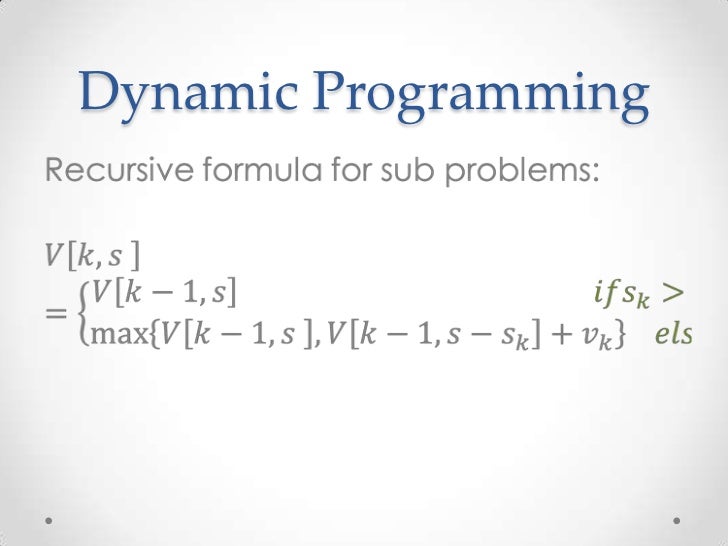

What items should the thief take? Dynamic-Programming Approach There are n items and weight of i th item is w i and the profit of selecting this item is p i. Problem StatementĪ thief is robbing a store and can carry a max imal weight of W into his knapsack. To solve 0-1 Knapsack, Dynamic Programming approach is required. Hence, it can be concluded that Greedy approach may not give an optimal solution. However, the optimal solution of this instance can be achieved by selecting items, B and C, where the total profit is 280 + 120 = 400. Hence, the total profit is 100 + 280 = 380. Using the Greedy approach, first item A is selected. Let us consider that the capacity of the knapsack is W = 60 and the items are as shown in the following table. Instead of selecting the items based on the overall benefit, in this example the items are selected based on ratio p i/w i. Whereas, the optimal solution can be achieved by selecting items, B and C, where the total profit is 18 + 18 = 36. Hence, for this given set of items total profit is 24. Without considering the profit per unit weight ( p i/w i), if we apply Greedy approach to solve this problem, first item A will be selected as it will contribute max imum profit among all the elements.Īfter selecting item A, no more item will be selected. Let us consider that the capacity of the knapsack is W = 25 and the items are as shown in the following table. The following examples will establish our statement. In many instances, Greedy approach may give an optimal solution. Greedy approach does not ensure an optimal solution. Hence, in case of 0-1 Knapsack, the value of x i can be either 0 or 1, where other constraints remain the same.Ġ-1 Knapsack cannot be solved by Greedy approach. This is reason behind calling it as 0-1 Knapsack. In 0-1 Knapsack, items cannot be broken which means the thief should take the item as a whole or should leave it. However, this chapter will cover 0-1 Knapsack problem and its analysis. We have shown that Greedy approach gives an optimal solution for Fractional Knapsack. In this tutorial, earlier we have discussed Fractional Knapsack problem using Greedy approach. Asymptotic Notations & Apriori Analysis.Here ‘i’ means the index of the element we are trying to store, w1_r means the remaining space of the first knapsack, and w2_r means the remaining space of the second knapsack. After little observation, we can determine that this can be represented in three states (i, w1_r, w2_r). To optimize the above idea, we need to determine the states of DP, that we will build up our solution upon. Recommended: Please try your approach on first, before moving on to the solution.Ī recursive solution is to try out all the possible ways of filling the two knapsacks and choose the one giving the maximum weight. Difference Between Symmetric and Asymmetric Key Encryption.

Analysis of Algorithm | Set 5 (Amortized Analysis Introduction).DDA Line generation Algorithm in Computer Graphics.Comparison among Bubble Sort, Selection Sort and Insertion Sort.

KNAPSACK DYNAMIC PROGRAMMING FREE
Data Structures and Algorithms Online Courses : Free and Paid.Generate all permutation of a set in Python.Converting Roman Numerals to Decimal lying between 1 to 3999.What is Algorithm | Introduction to Algorithms.Recursive Practice Problems with Solutions.Analysis of Algorithms | Set 4 (Analysis of Loops).SDE SHEET - A Complete Guide for SDE Preparation.Understanding Time Complexity with Simple Examples.Analysis of Algorithm | Set 4 (Solving Recurrences).Analysis of Algorithms | Set 2 (Worst, Average and Best Cases).Analysis of Algorithms | Set 3 (Asymptotic Notations).Analysis of Algorithms | Set 1 (Asymptotic Analysis).Top 50 Array Coding Problems for Interviews.ISRO CS Syllabus for Scientist/Engineer Exam.ISRO CS Original Papers and Official Keys.



 0 kommentar(er)
0 kommentar(er)
